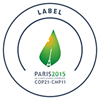�
Our Common Future Under Climate Change
International Scientific Conference 7-10 JULY 2015 Paris, France
Royce Bair
Blaming climate change: processes and methods
201507-16
By Fay Newbery, University of Reading
It�s easy to see recent patterns of change and want to blame climate change but how do we know that climate change is responsible?
This is the topic that Wolfgang Cramer, one of the IPCC Fifth Assessment Report Working Group II members, delivered at the Our Common Future Under Climate Change conference.
Attributing (blaming) climate change for an observed change is a two-stage process. First a change needs to be detected and then climate change has to be shown to be the cause.
Many physical and biological systems, such as the size of glaciers or the upper altitudinal limits of coniferous forests, are more or less stable, although with seasonal or year to year variability. Change can, therefore, be detected as a difference in the long-term mean measure.
Human-based systems, however, are often undergoing change. Wheat yields in Europe, for example, increased steadily between 1950 and the middle of the 1990�s. This was due to technological developments that included plant breeding, better nutrient provision, better pest and disease protection and improvements in farm machinery. In such cases �change� that may be caused by climate change can be suspected when the pattern of change changes. For example, wheat yields stopped rising in the mid-1990�s. Was this because of climate change or were other factors at work?
(Picture credit: IPCC Working Group II)
Statistics can be used to detect underlying change amongst seasonal or year-to-year variation but cannot make a judgement on the cause. This requires human examination of the facts and very careful study of other possible causal factors. Once change is proved, observations need to be shown to be �consistent with a climate effect and inconsistent with plausible alternatives�, said Cramer.
Scientists preparing the IPCC Fifth Assessment report required themselves to go even further. Cramer told his audience that an attribution statement needs to indicate �how much of the observed change is due to climate change � with an associated confidence statement.�
Using this methodology the IPCC Working Group II managed to map climate change effects to major regions of the world, separating minor and major contributions of climate change and giving a 5-point confidence scale ranging from very low to very high confidence.
This was carried out for physical, biological and human systems by a networked team of experts who re-examined hundreds of diverse studies of local and regional change.
Cramer had one important caveat to make: �Absence of attributed impacts does not mean that no impacts have occurred. Many impacts may not have been observed, or their attribution is unclear.�
With the clear methodology developed for the IPCC Fifth Assessment, assigning blame has become a rigorous process that can be used to further our understanding of the effects of climate change on the world we live in.
Fay Newbery is a PhD student at the University of Reading studying climate effects on crop disease. She is part of the volunteer social media team at the Our Common Future Under Climate Change conference.
This is part of a blog series written by volunteer social reporters profiling climate scientists, economists, social scientists and civil society members who are presenting and discussing innovative climate science at Our Common Future. For more follow @ClimatParis2015 and #CFCC15 on Twitter.
�



